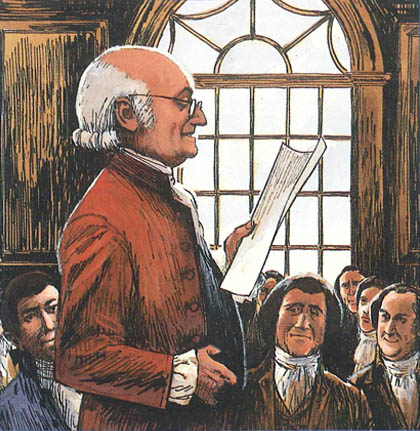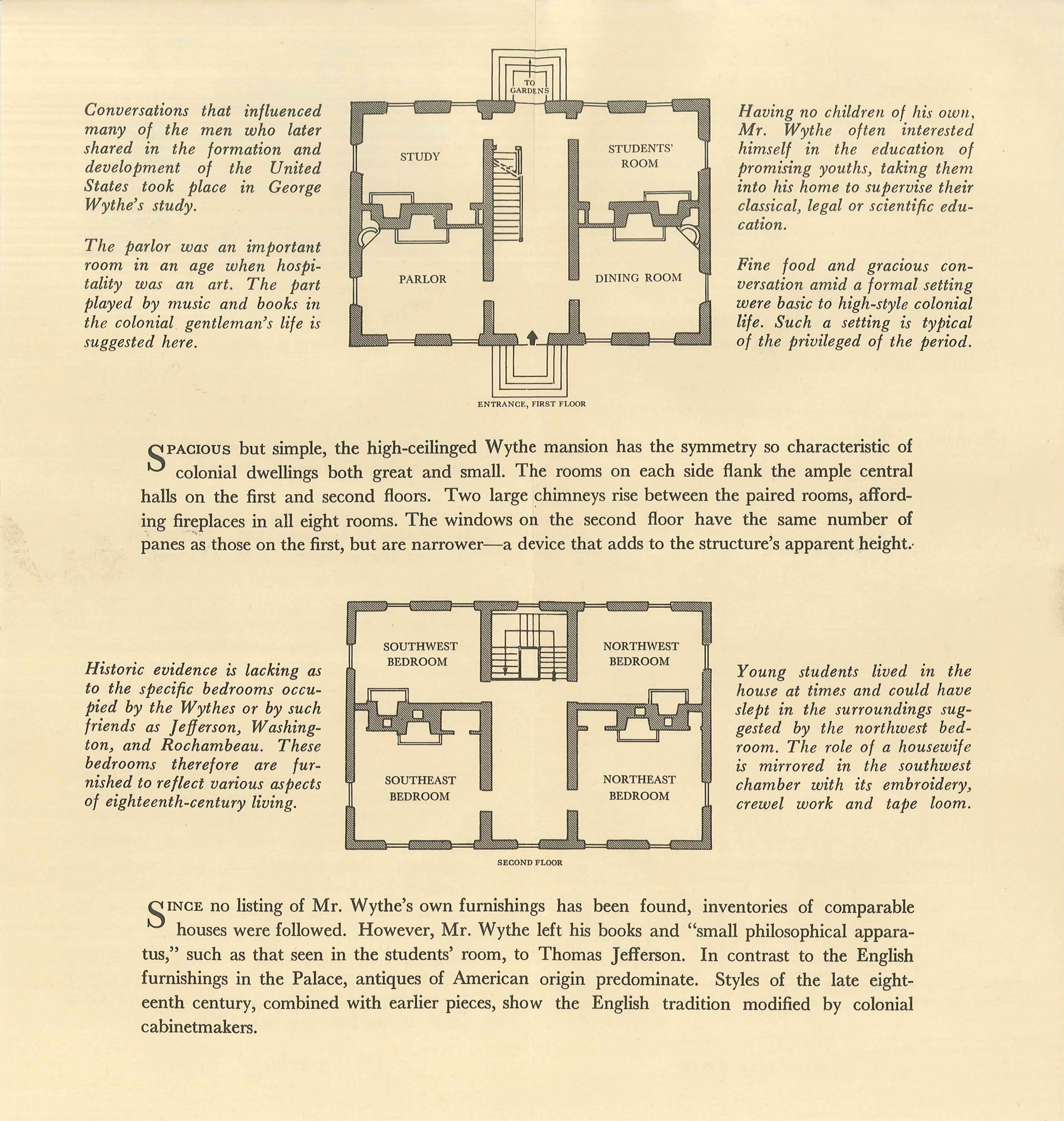Wythe the Teacher
| Wythe's Students | |
| Wythe's Legal Apprentices, 1762-1779 | |
| Wythe's Students at William & Mary, 1779-1790 | |
| |
| Wythe's Students/Apprentices, 1790-1806 | |
The American Revolution severed most ties with England and created a dearth of available legal training for would-be lawyers. Thomas Jefferson, then governor of Virginia, saw the need for legal reorganization in the colonies (and soon to be new nation) and chose to enact his reforms at his alma mater, the College of William & Mary.[1] At Jefferson's urging, the College's Board of Visitors (of which he was a member) created a professorship of Law and Police in 1779 and named George Wythe, Jefferson's mentor, to that position.
Jefferson knew Wythe well, and had served as Wythe's his legal apprentice from 1762-1765.[2] Other notable apprentices of Wythe prior to his appointment as a law professor were the Reverend James Madison (who later became President of the College as well as the first Episcopal Bishop of the Diocese of Virginia) and St. George Tucker (who succeeded Wythe as the second Professor of Law and Police at William & Mary, and is best known as the author of the first American edition of Blackstone's Commentaries, commonly known as Tucker's Blackstone).
During its first full year of operation in 1780, at least eight students were associated with the law curriculum at the College, one of whom was John Marshall, who would later serve as Chief Justice of the Supreme Court of the United States.[3] Because there was no cohesive legal collection in the College's library at that time, Wythe used his personal collection, relying heavily on Matthew Bacon's New Abridgment of the Law[4] and Sir William Blackstone's Commentaries on the Laws of England.[5] But a young man who studied with George Wythe would learn much more.
Although as a professor at William and Mary Wythe emphasized the study of political economy and public law, his students received a formal grounding in the English common law, with Blackstone's Commentaries on the Laws of England being the basic text for his lectures. Students also were encouraged to read much more, to attend other lectures at the college, and to observe proceedings at the capital. Those able to do so received tutorial instruction from Wythe that extended from the classics to contemporary economics and politics; but to study with Wythe in this way, one needed to be a competent reader of Greek, Latin and French.[6]
Wythe can be credited for introducing a moot legislature and moot court to American law students, the latter of which has remained a staple of legal education for more than two centuries:
In addition to the lectures and readings, for his students Wythe designed two institutions which were new to North America. The first was a moot court, the concept for which likely came from the London Inns of Court, which, a couple of centuries previous, had held "'mootings." These earlier exercises had seen the member-barristers deliver arguments on both sides of set cases [footnote omitted]; however, Wythe reversed the process by having the students themselves do the arguing.
Wythe's second institutional innovation was the moot legislature. This too was held in the old Capitol, in the legislative chamber last used by the General Assembly on Christmas Eve 1779 [after which the capitol was moved from Williamsburg to Richmond], and Wythe served as Speaker while his students debated the merits of proposed legislation.
Wythe designed his moot legislature to prepare his students for the leading roles that he anticipated them soon taking in the state and national legislatures, and his ultimate goal was to create a class of ardent, well-prepared republicans.[7]
There would be many 'ardent, well-prepared republicans'. All told, Wythe taught law to perhaps 200 men, including delegates to the Continental Congress (John Brown); one or two Presidents (Jefferson and James Monroe)[8] and a Vice President of the United States (Jefferson); one or two Secretaries of State (Henry Clay and Edmund Randolph);[9] two Attorneys General of the United States (Randolph was the first Attorney General of the U.S., and Breckenridge served as Attorney General under Jefferson); U.S. Senators (Breckenridge; John Brown, and Littleton Waller Tazewell), a Speaker of the House of Representatives (Clay), two U.S. Supreme Court Justices (Marshall and Bushrod Washington); state supreme court (Spencer Roane in Virginia) and federal district court judges; a foreign minister (Jefferson); governors (Jefferson, Tazewell and William Branch Giles; members of several state legislatures (Kentucky, North Carolina and Virginia); and a president of William & Mary (The Rev. James Madison).[10]
Jefferson remained Wythe's strongest supporter throughout his mentor's tenure at the College. On July 17, 1788, then serving as Minister to France, Jefferson wrote this letter to Ralph Izard (a member of the Continental Congress and United States Senator) about William & Mary's law program:
Wythe tutored younger students even while teaching law at the College. Already in his 60's and nearing the end of his tenure at William & Mary, Wythe taught 13-year old William Munford (a future member of both the Virginia House of Delegates and Senate, and Law Reporter for the decisions of the Virginia Supreme Court of Appeals) and Littleton Waller Tazewell (who would later serve in the United States House and Senate, and as governor of Virginia). The excerpt below describes a typical day of 12-year old Tazewell's studies with Wythe:
In 1789 Wythe resigned his position at William & Mary and moved to Richmond because of his duties as Chancellor of the High Court. He didn't stop teaching, however. One of his 'pupils', a young Henry Clay, served as Wythe's secretary and amanuensis at the court. Clay later served as Speaker of the Kentucky House of Representatives, United States Senator, Speaker of the U.S. House of Representatives, and Secretary of State.
So highly regarded was Wythe at William & Mary that Jefferson remarked upon his resignation that "it is all over with the College."[13] But the school found a worthy replacement in St. George Tucker, who began teaching in September 1790.[14] As deserving as this appointment was, it is no surprise that the modest Tucker asked that others not compare him to his predecessor.[15] No one would wish to be compared with Chancellor Wythe, whose "teaching career may be assessed . . . as consequential beyond comparison to that of any successor in American university law teaching."[16]
See also
- George Wythe, America's First Law Professor and the Teacher of Jefferson, Marshall, and Clay
- The Teaching of George Wythe
- Virginia Gazette, 2 August 1787
References
- ↑ "Jefferson had attempted to make these changes by an act of Assembly, but the dissenters from the Church of England killed the bill because they did not want William and Mary, which was then an Episcopal college, to be strengthened in any way. Therefore, Jefferson had to make his reforms by acting through the college's board of visitors. In 1779 Jefferson and Madison called their former law teacher, Chancellor Wythe, to the new professorship of law. It is difficult to conceive that anyone more acceptable, more appropriate, more competent, or more scholarly could be found; no one else was considered." W. Hamilton Bryson, Legal Education in Virginia, 1779-1979: A Biographical Approach (Charlottesville: University Press of Virginia, 1979), 22.
- ↑ "Mr. Wythe continued to be my faithful and beloved Mentor in youth, and my most affectionate friend through life." Thomas Jefferson Randolph, ed., Memoir, Correspondence, And Miscellanies, from The Papers of Thomas Jefferson, 2nd ed.(Boston: Gray and Bowen, 1830), 1:2. See also Thomas Hunter, "The Teaching of George Wythe," in The History of Legal Education in the United States: Commentaries and Primary Sources, ed. Lee Sheppard (Pasadena, Calif.: Salem Press, 2007), 142.
- ↑ There were at least eight students "since there were enough to form two moot court teams of four each. One of them was John Marshall, who remained only a few months. In a letter to James Madison, Jefferson praised the beginning that Wythe had made, remarking: 'Our new institution at the college has had a success which has gained it universal applause...'" Susan H. Godson et. al., The College of William and Mary: A History (Williamsburg, Va.: King and Queen Press, 1993), 136.
- ↑ R. Kent Newmyer, John Marshall and the Heroic Age of the Supreme Court (Baton Rouge: Louisiana State University Press, 2001), 78. See also William F. Swindler, "John Marshall's Preparation for the Bar–Some Observations on His Law Notes," American Journal of Legal History 11 (1967), 207.
- ↑ Paul D. Carrington, "The Revolutionary Idea of University Legal Education," William and Mary Law Review 31 (1990), 535.
- ↑ Carrington, "The Revolutionary Idea of University Legal Education," 535.
- ↑ Hunter, "The Teaching of George Wythe," 145-146.
- ↑ Historians disagree as to whether James Monroe studied law under Wythe.
- ↑ As with James Monroe, it is possible, but not certain, that Edmund Randolph studied under Wythe.
- ↑ Imogene E. Brown, American Aristides: A Biography of George Wythe (Rutherford: Fairleigh Dickenson University Press, 1981), 213-214. See also Hunter, "The Teaching of George Wythe," 153-154.
- ↑ Robert M. Hughes, "William and Mary, the First American Law School," William and Mary Quarterly, 2nd Ser., 2 (January, 1922), 42.
- ↑ Brown, American Aristides, 220-221 (citing Littleton Walter Tazewell, "An Account and History of the Tazewell Family," Virginia State Library Manuscripts Collection). See also W. Hamilton Bryson, "The History of Legal Education in Virginia," University of Richmond Law Review 14 (1979-80), 171-172.
- ↑ "In 1788 the courts of Virginia were reorganized, and Chancellor Wythe was required to move his residence to Richmond. This forced his resignation in 1789 of the professorship in Williamsburg after a decade of lecturing." Bryson, Legal Education in Virginia, 24. Another account has Wythe resigning "in anger at the college." Carrington, 537.
- ↑ Tucker was the college rector at the time he succeeded Wythe. "Tucker, learned in the law and closely associated with the college, was the logical choice to replace Wythe. His recognition as a legal scholar was widespread and his connection with the college strong." Charles T. Cullen, St. George Tucker and Law in Virginia, 1772-1804 (Garland, 1987), 118. "Tucker was arguably the most important American legal scholar of the first half of the nineteenth century." Carrington, "The Revolutionary Idea of University Legal Education," 540.
- ↑ Cullen, St. George Tucker and Law in Virginia, 119.
- ↑ Carrington, "The Revolutionary Idea of University Legal Education," 538.
External links
- Jack Lynch, "'His Integrity Inflexible, and His Justice Exact'," Colonial Williamsburg Journal (Spring 2010).

